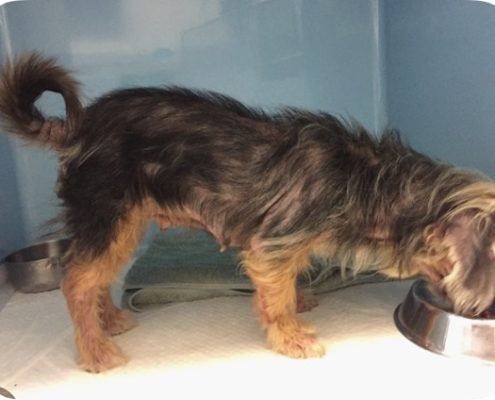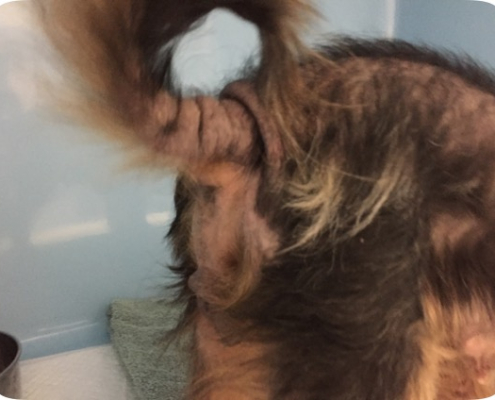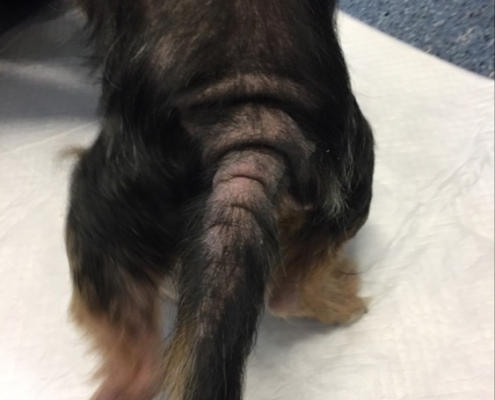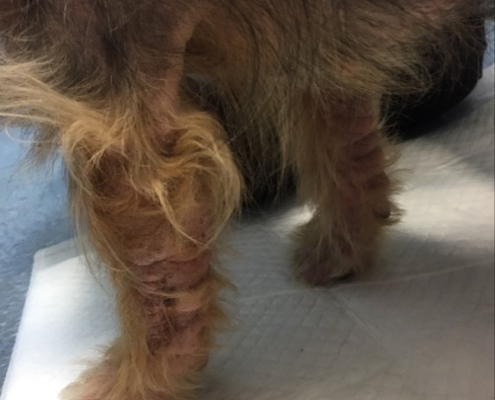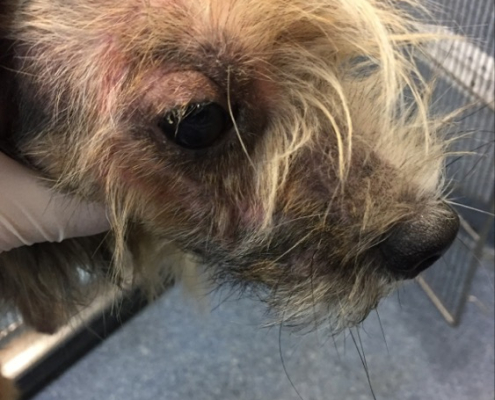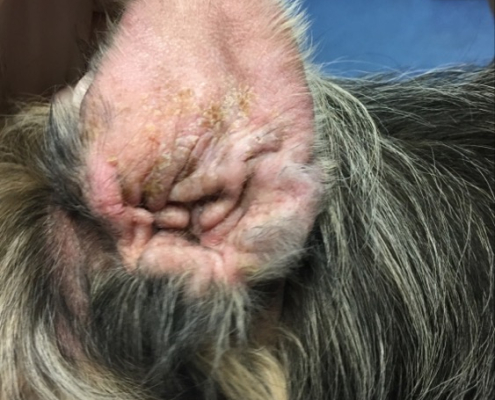Unraveling Canine Atopy: Understanding, Treating, and Finding Relief
At Nicklin Way Veterinary Surgery, we frequently encounter one of the most prevalent allergic skin conditions affecting dogs: Atopy. In this informative blog post, we’ll delve into the details of this chronic inflammatory skin condition and how it impacts your beloved furry friend.
The Main Allergic Culprit: Inhalation of Pollen
Atopy is a chronic inflammatory skin ailment triggered by various environmental substances. The leading cause of atopy is the inhalation of pollen present in the air. Think of it as akin to human hay fever, but dogs can’t express their discomfort with sneezing and teary eyes. Instead, their immune system goes into overdrive when exposed to inhaled pollen, resulting in inflammation and itching, particularly in the duck webs between the toes (as I like to call them), the interdigital skin. As atopy progresses, you may observe severe itching in areas around the eyes, snout, groin, armpits, and flanks. The persistent inflammation disrupts the skin’s normal functioning, leading to the development of cracks. This, in turn, fosters the rapid proliferation of yeast and bacteria, which can exacerbate itching, produce yellowish skin flakes, and hair loss, and emit a distinctive musty odour. Ear infections are also common in atopy cases due to the ear lining being akin to skin—making it an ideal breeding ground for yeast in a warm, oxygen-deprived environment. Another inconvenience often faced by owners of atopic dogs is discomfort caused by inflamed and swollen anal glands.
Addressing the Itch: Two-Fold Approach
To effectively address atopy, it’s crucial to distinguish between the two types of itch it causes. The first stems from the pollen allergy, the root cause, while the second arises from bacterial overgrowth, a consequence of the allergy.
When you bring your dog for a skin consultation, your vet will conduct a thorough examination, explaining atopy and ruling out other conditions that may resemble it, such as primary food allergies or flea bite allergies. They’ll also check for concurrent skin and ear infections, as well as the status of the anal glands. Your vet might recommend a food trial to eliminate other potential causes of the skin condition.
If primary atopy is suspected, your vet may offer a referral to a dermatologist. The specialist will conduct tests under anesthesia to pinpoint your dog’s specific allergies and formulate a vaccine for you to administer at home. This treatment approach can take a year or more to yield results and may vary in effectiveness.
However, if you opt for treatment at our clinic, we’ll provide you with a range of options to address the primary itch, allowing you to select the one that best suits your dog and your preferences.
In the past, immunosuppressive drugs like prednisolone were the primary treatment options for atopy, but they often led to undesirable side effects due to the chronic nature of the condition. Fortunately, for the past decade, we’ve had access to innovative medications such as Apoquel and Cytopoint. Unlike their predecessors, these drugs modulate and regulate the immune system rather than suppressing it. Apoquel, available as a daily tablet, inhibits the production of a protein that instructs immune cells to attack allergens. Cytopoint, administered as a monthly injection, mimics your dog’s immune system by blocking the protein responsible for triggering itching.
As atopy frequently gives rise to secondary problems like ear infections, treatment typically includes eardrops, antibiotics, and medicated shampoo to tackle infected ears and skin.
Meet Sophie…
Sophie was found wandering in the forest, suffering from bad skin atopy. See below for how she looks now!
Common Questions About Atopy
Here are answers to some of the most frequently asked questions in my consultations regarding atopy:
1. What kinds of tests might your veterinarian suggest?
If atopy has progressed, skin, ear, or anal gland infections may be present, caused by various yeast and bacteria strains. Your vet may recommend taking a sample for microscopic analysis to identify the specific bacteria, allowing for precise antibiotic treatment.
2. What can I do at home?
Some owners find that feeding a low-allergen diet can enhance the effectiveness and duration of medications. Studies indicate that probiotics can benefit overall inflammation by promoting gut health. Additionally, high-quality omega-3 and omega-6 fatty acid oils can help fortify the skin’s natural barrier against inflammation, although it’s important to note that these should be avoided if your dog is on a strict food allergy diet or has a history of pancreatitis.
3. Will this condition last for the rest of his/her life?
Owners of dogs with atopy often notice seasonal patterns in their pet’s allergies. While atopy is lifelong, some owners can manage symptoms and reduce medication during specific seasons. However, discontinuing treatment for extended periods may lead to flare-ups and secondary infections. Many owners choose to continue medication year-round to ensure their pets remain comfortable.
A Path to Relief: Overcoming the Itch
Dealing with a chronic condition that leaves your pet itching incessantly and often emitting an unpleasant odor can be incredibly trying. While the treatment process may seem intensive initially, as it addresses both the primary itch and secondary infections simultaneously, rest assured that in just a few weeks, you and your pet will transition to a maintenance stage. Owners often express immense relief and joy as they witness their itch-free, glossy-coated pets, and that’s a source of immense satisfaction for our veterinary team too!
Sophie today…
She doesn’t look like the same dog!

Written by Dr Ruby Schrijnders-Schmidt

